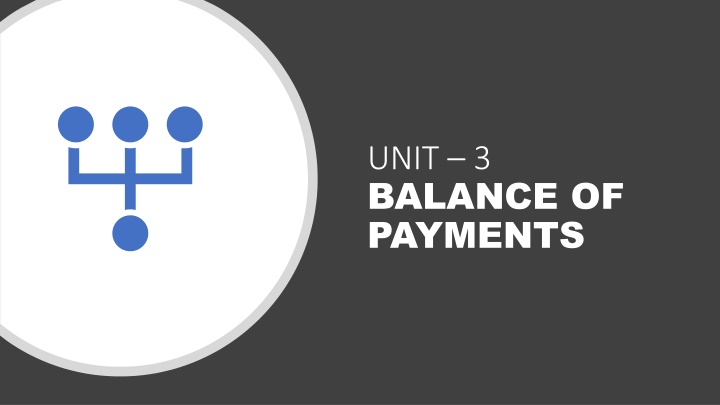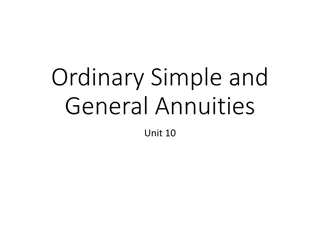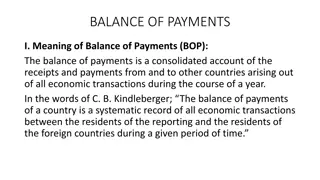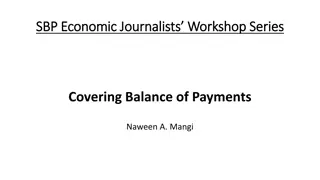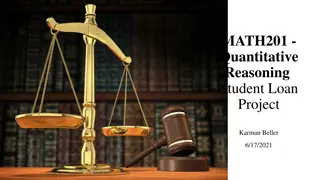Balance of Payments: Meaning and Components
The balance of payments (BOP) reflects all transactions between a country and the world. It consists of the current account, capital account, and financial account. Equilibrium and disequilibrium in the BOP indicate balance or imbalance in foreign currency demand and supply, affecting a country's overall financial position.
Download Presentation

Please find below an Image/Link to download the presentation.
The content on the website is provided AS IS for your information and personal use only. It may not be sold, licensed, or shared on other websites without obtaining consent from the author.If you encounter any issues during the download, it is possible that the publisher has removed the file from their server.
You are allowed to download the files provided on this website for personal or commercial use, subject to the condition that they are used lawfully. All files are the property of their respective owners.
The content on the website is provided AS IS for your information and personal use only. It may not be sold, licensed, or shared on other websites without obtaining consent from the author.
E N D
Presentation Transcript
UNIT 3 BALANCE OF PAYMENTS
3.1 MEANING AND COMPONENTS IN THE BALANCE OF PAYMENT What is the Meaning of Balance of Payments (BOP)? The balance of payments (BOP) is a statement of all transactions made between entities in one country and the rest of the world over a defined period of time, such as a quarter or a year. The balance of payments consists of three components: the current account, the capital account and the financial account. The current account reflects a country's net income, while the capital account reflects the net change in ownership of national assets.
When the demand and supply of any foreign currency in a country in a given time period is equal, it is termed as Equilibrium position' in the balance of payment. While a disequilibrium means that the condition is either deficit or surplus. 3.1 MEANING AND COMPONENTS IN THE BALANCE OF PAYMENT The Equilibrium and Disequilibrium in the Balance of Payments! Before we analyse the causes of disequilibrium in the balance of payments, we would like to explain what is meant by equilibrium in the balance of payments. When we add up all the demand for foreign, currency and all the sources from which it comes, these two amounts are necessarily equal and thus the overall account of the balance of payments necessarily balance or must always be in equilibrium.
3.1 MEANING AND COMPONENTS IN THE BALANCE OF PAYMENT What then do we mean by when we say that the balance of payments of a country is 'in equilibrium or disequilibrium' As a matter of fact, when we speak of equilibrium or disequilibrium in the balance of payments we refer to the balance on those parts of the account which do not include the accommodating items such as borrowing from the IMF, use of SDRs, drawing from the reserves of foreign currencies held by the Central Bank, etc.
When excluding these accommodating items there is neither deficit nor surplus in the overall balance of payments, it is said to be in equilibrium. When in this sense, there is either deficit or surplus, the balance of payments is said to be in disequilibrium. The deficit in balance of payments can be financed by drawings from the IMF, use of SDRs, drawings from the reserves of foreign and loan and aid received from abroad. For currencies example in 200102, we added to our foreign exchange reserves to the tune of 11757 million US dollars. 3.1 MEANING AND COMPONENTS IN THE BALANCE OF PAYMENT
3.1 MEANING AND COMPONENTS IN THE BALANCE OF PAYMENT However for previous several years India's balance of payment on current account was in deficit. To finance the deficits India borrowed from IMF or from other countries o even resorted to commercial borrowing from abroad. But India's balance of payments for the year 2001-02 was favourable.
Basic Balance of Payments, Autonomous Items and Accommodating Items: 3.1 MEANING AND COMPONENTS IN THE BALANCE OF PAYMENT However, a more important and popular concept of balance of payments equilibrium has been of basic balance. The concept of basic balance is based upon the idea of autonomous items in the balance of payments. The autonomous items in the balance of payments are those items which cannot be influenced or changed so easily or quickly by the Government and they are determined by some long-term factors.
items in the current account, the long term capital movements both on private or Government account contained in the capital- account balance of payments are regarded as autonomous. On the other hand, in the capital account short-term capital movements such as borrowing from IMF or Central Banks of other countries, drawings from SDR, change in foreign exchange reserves are transitory and of accommodating nature and are therefore excluded from the concept of basic balance or of equilibrium. In this concept of basic balance, besides the 3.1 MEANING AND COMPONENTS IN THE BALANCE OF PAYMENT
3.1 MEANING AND COMPONENTS IN THE BALANCE OF PAYMENT The concept of balance of payments in the sense of basic balance can be represented by the following equation: (X-M) + LTC = O M stands for imports including invisible items. LTC stands for long-term capital movements. If (X- M) is positive (i.e., X > M). then for balance of payments to be in equilibrium, LTC will be negative and equal to (XM). This implies that there will be net capital outflow. On the other hand, if M > X, then for the balance of payments to be in equilibrium LTC must be positive Where X stands for exports including invisible items.
Causes and Measures of Disequilibrium! 3.2 CAUSES AND MEASURES TO CORRECT BOP DISEQUILIBRIUM Overall account of BOP is always in equilibrium. This balance or equilibrium is only in accounting sense because deficit or surplus is restored with the help of capital account. In fact, when we talk of disequilibrium, it refers to current account of balance of payment. If autonomous receipts are less than autonomous payments, the balance of payment is in deficit reflecting disequilibrium in balance of payment.
Causes of disequilibrium in BOP: 3.2 CAUSES AND MEASURES TO CORRECT BOP DISEQUILIBRIUM There are several factors which cause disequilibrium in the BOP indicating either surplus or deficit. Such causes for disequilibrium in BOP are listed below: Economic Factors Political Factors Social Factors
2. Measures to correct disequilibrium in BOP: 3.2 CAUSES AND MEASURES TO CORRECT BOP DISEQUILIBRIUM Following remedial measures are recommended: Export promotion Import Reducing inflation Exchange control Devaluation of domestic currency Devaluation of domestic currency
What Was the Bretton Woods Agreement and System? July 1944 by delegates from 44 countries at the United Nations Monetary and Financial Conference held in Bretton Woods, New Hampshire. Thus, the name "Bretton Woods . Under the Bretton Woods System, gold was the basis for the U.S. dollar and other currencies were pegged to the U.S. dollar's value. The Bretton Woods System effectively came to an end in the early 1970s when President Richard M. Nixon announced that the U.S. would no longer exchange gold for U.S. currency. The Bretton Woods Agreement was negotiated in 3.3 PROCESS OF ADJUSTMENT UNDER GOLD STANDARD AND FIXED EXCHANGE RATE
This could be the exchange rate which was the US gold export point or upper specie point. No US importer would pay more than $ 6.03 to obtain E 1 because he could buy $ 6 worth of gold from the US treasury and ship it to Britain at a cost of 3 cents per ounce. This tends to bring about a new equilibrium at PI and a new exchange rate at OEI whereby the deficit in the balance of payments is eliminated. The demand for foreign exchange equals the supply of foreign exchange at OQI and the balance of payments is in equilibrium. When exchange depreciation takes place, foreign prices are translated into domestic prices. Suppose the dollar depreciates in relation to the pound. 3.3 PROCESS OF ADJUSTMENT UNDER GOLD STANDARD AND FIXED EXCHANGE RATE
It means that the price of dollar falls in relation to the pound in the foreign exchange. What is important is low elasticities of demand and supply of foreign exchange. 3.3 PROCESS OF ADJUSTMENT UNDER GOLD STANDARD AND FIXED EXCHANGE RATE Automatic Price Adjustment under Flexible Exchange Rates (Price Effect): Under flexible (or floating) exchange rates, the disequilibrium in the balance of payments is automatically solved by the forces of demand and supply for foreign exchange. An exchange rate is the price of a currency which is determined, like any other commodity, by demand and supply.
It means that the price of dollar falls in relation to the pound in the foreign exchange. What is important is low elasticities of demand and supply of foreign exchange. 3.3 PROCESS OF ADJUSTMENT UNDER GOLD STANDARD AND FIXED EXCHANGE RATE Automatic Price Adjustment under Flexible Exchange Rates (Price Effect): Under flexible (or floating) exchange rates, the disequilibrium in the balance of payments is automatically solved by the forces of demand and supply for foreign exchange. An exchange rate is the price of a currency which is determined, like any other commodity, by demand and supply.
Assumptions: 3.3 PROCESS OF ADJUSTMENT UNDER GOLD STANDARD AND FIXED EXCHANGE RATE There are two countries Britain and U.S. Both are on flexible exchange rate system. BOP disequilibrium is automatically adjusted by changes in exchange rates. Prices are flexible in both the countries. There is free trade between the two countries.
Explanation: Given these assumptions, the adjustment process is explained in terms of Figure 1 where D is the U.S. demand curve of foreign exchange representing its demand for British imports, and S is the U.S. supply curve of foreign exchange representing its exports to Britain. At P the demand and supply of the U.S. foreign exchange is in equilibrium where the rate of exchange between U.S. dollar and British pound is OE. 3.3 PROCESS OF ADJUSTMENT UNDER GOLD STANDARD AND FIXED EXCHANGE RATE
The rate at which the standard money of the country was convertible into gold was called the mint price of gold. This rate was called the mint parity or mint par of exchange because it was based on the mint price of gold. But the actual rate parity by the cost of shipping gold between the two countries of exchange c 3.3 PROCESS OF ADJUSTMENT UNDER GOLD STANDARD AND FIXED EXCHANGE RATE It's Criticism: severely limited. Depreciation and appreciation lead to fall and rise in prices in the countries adopting them. They lead to severe depressions inflations respectively. Further, they create insecurity and uncertainty. below the mint The practical use of flexible exchange rates is
Merits of Fixed Exchange Rate System: 1. Exchange Rate Stability 2. Promotes Capital Movements 3. Prevents capital outflow 4. Prevents Speculation in foreign exchange market 5. Serves as an anchor against inflation 6. Promotes economic integration of the world 7. Promotes growth of internal money and capital markets 3.4 MERITS AND DEMERITS OF FIXED EXCHANGE RATE foreign exchange market:
Demerits and Problems of Fixed Exchange Rate System: that the countries with a large and persistent balance of payments deficits were losing gold and other foreign assets. This could not go on forever as evidently stock of gold and foreign currencies would have run out. That is why the USA abandoned Bretton Woods System which represented fixed exchange rate system. The other countries facing problem of balance of payment deficit found their international reserves dwindling which forced them to devalue their currency. The devaluation has an inflationary potential. Fixed exchange rate had however a great flaw in 3.4 MERITS AND DEMERITS OF FIXED EXCHANGE RATE
